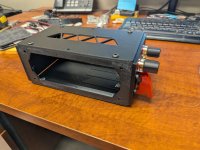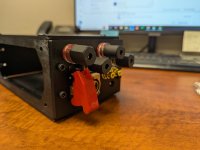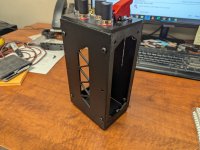^ It is important to remember that with an ACA (if built per the guide) that the RED binding posts are at GND potential.
I don't know what the sub is "expecting", but I'd assume that that "black" is intended to be at reference => GND potential vs. connected to what in this case would be the positive phase output signal on the left channel (in bridged / balanced mode). That is if and only if the back panel is correct (and If I understood it properly).
If you can't find someone at the sub manufacturer and/or someone willing to tell you that they'll put your $$ on the line for their knowledge... I'd go with the sacrilegious method of connecting the sub(s) to your pre-amplifier at line level... or use a different sub manufacturer that doesn't have a preconceived notion that the "character" of the power amplifier should be carried to the subwoofer.
One opinion... one suggestion... there will likely be equally valid opinions that differ.
Also... it's important to note in the photo that the speaker wires are not connected per the back panel instructions for balanced / bridged unless the user intended to invert phase at the speaker and/or is using unconventional colors for wiring. Output 'A' is on the right in this photo, and (+) is connected and vice versa.
So, tl;dr -- I may have it wrong, and I often do. However, IMO, if you're going to do this, it's critical to understand each connection, the signal or ground wiring in the ACA, and what your sub is "expecting" on each wire. You're wise to ask for guidance... my guidance is to use line level connections.

I don't know what the sub is "expecting", but I'd assume that that "black" is intended to be at reference => GND potential vs. connected to what in this case would be the positive phase output signal on the left channel (in bridged / balanced mode). That is if and only if the back panel is correct (and If I understood it properly).
If you can't find someone at the sub manufacturer and/or someone willing to tell you that they'll put your $$ on the line for their knowledge... I'd go with the sacrilegious method of connecting the sub(s) to your pre-amplifier at line level... or use a different sub manufacturer that doesn't have a preconceived notion that the "character" of the power amplifier should be carried to the subwoofer.
One opinion... one suggestion... there will likely be equally valid opinions that differ.
Also... it's important to note in the photo that the speaker wires are not connected per the back panel instructions for balanced / bridged unless the user intended to invert phase at the speaker and/or is using unconventional colors for wiring. Output 'A' is on the right in this photo, and (+) is connected and vice versa.
So, tl;dr -- I may have it wrong, and I often do. However, IMO, if you're going to do this, it's critical to understand each connection, the signal or ground wiring in the ACA, and what your sub is "expecting" on each wire. You're wise to ask for guidance... my guidance is to use line level connections.
Last edited:
I clearly didn't understand the back panel for the ACA. It was kindly pointed out to me that the box in red below ... is the box to look at for XLR input balanced / bridged. And, well.... that makes sense since the box is around the XLR input. 🙂 
So, the phase is correct in the photo for typical speaker wiring. Apologies for any confusion. The black dot in the proposed sub connection would be connected to the inverted phase signal vs. the 'positive' signal.... I think...


So, the phase is correct in the photo for typical speaker wiring. Apologies for any confusion. The black dot in the proposed sub connection would be connected to the inverted phase signal vs. the 'positive' signal.... I think...
Connecting a subwoofer via high-level from mono bridged ACAs makes my head hurt even thinking about it. Ground isn't common between the two amps, ground doesn’t really exist because they are bridged, and there’s a strong possibility of loops carrying real and possibly damaging current…
I personally don’t recommend trying, just use low-level to the subs.
I personally don’t recommend trying, just use low-level to the subs.
Last edited:
I am relieved to read that two people I trust here on the forums are equally as...suspicious???skeptical???... in regards to these connections.
In the amplifier operating mode in this picture, If you put a 2k resistor in parallel with each side of the output, the amp is blissfully unaware that anything is connected to it.
It would look like this - one for each side of the speaker output.

It would look like this - one for each side of the speaker output.
I will forget REL's subwoofer. I am really happy that there is a place to ask, before buying and doing something really stupid with those "not so typical connections".
I bought a pair of ACA boards to make nice little monoblocks for my PC setup. Living in Canada makes it pretty hard to justify the cost of the chassis with parts and shipping so I was able to purchase everything from Mouser and I've actually designed some 3D printed chassis in fusion 360. When all is said and done I'll most likely have the top & bottom covers lasercut from 1/8" steel and use high temp filament for the rest.
I still have a few fitment issues to work out on the chassis, but once I'm finished I'll make the files available publicly for anyone to download.
I still have a few fitment issues to work out on the chassis, but once I'm finished I'll make the files available publicly for anyone to download.
Attachments
That looks fantastic! Thank you and looking forward to how this all comes together. 🙂 🙂
Quick question - I'm building a second ACA but was planning to just keep it stereo only and no balanced input. Is there any problem eliminating the 39k resistor used on the rear panel wiring? Also, since I'll be running RCA inputs only , do you still need to run the buss bar / ground to the red/+ RCA input jacks?
My plan was to completely eliminate the DPDT switch and balanced output, run the board audio out +/- to the speaker outputs and run the power jack ground tab to the board ground only. It'll be grounded to the chassis through the board.
Assuming this would be OK but wanted to double check
My plan was to completely eliminate the DPDT switch and balanced output, run the board audio out +/- to the speaker outputs and run the power jack ground tab to the board ground only. It'll be grounded to the chassis through the board.
Assuming this would be OK but wanted to double check
For any others- answered my own question: Saw in the 1.6 build guide I believe - had a rear panel wiring layout that filled the bill without the resistor. I just eliminated the bal input and its working great! Did the Nichicon KG gold tune cap 47k 63V for C1 spot and Elna silmic2's for C2,3 and 4. Will see how these sound for a while then maybe swap out to the aluminum organic caps at 2,3,4 spots. So far sounding really nice!
Next project- either an Aleph or Phonostage. . .

Next project- either an Aleph or Phonostage. . .
@blue360cuda Super clean layout! What was your objective in making these changes? Is the difference in sound noticeable?
Thanks! I hate having a rats nest of wires if needing to troubleshoot and like how solid core bends and stays put so things look tidy. The Belden 9497 has a big following with the tube amp guys, which I mainly am, so had a big stash of that lying around - used it for the output wiring here.
Made the changes based on the "ACA with premium parts" post. I did the aluminum organic caps in my first ACA but kept the CD C1 filter cap. Always had good luck with the Elna 'lytics in other projects and happened to have the correct values in my stash so wanted to hear how they sounded. The KG gold tune got good marks by other uses so jumped right for that one. Bought a quad of the KG gold tunes so will probably swap the CD out of my first ACA for a KG as well.
In regards to the rear panel, I don't have any balanced output gear at all so no need but I will put a cover plate or something there. Will end up doing the switch but didnt have a 3 position one on hand, only a SPST 2 position toggle. Will do the 3 position toggle so I can play around with bridging the amps down the road. Will add the resistor when that happens.
Made the changes based on the "ACA with premium parts" post. I did the aluminum organic caps in my first ACA but kept the CD C1 filter cap. Always had good luck with the Elna 'lytics in other projects and happened to have the correct values in my stash so wanted to hear how they sounded. The KG gold tune got good marks by other uses so jumped right for that one. Bought a quad of the KG gold tunes so will probably swap the CD out of my first ACA for a KG as well.
In regards to the rear panel, I don't have any balanced output gear at all so no need but I will put a cover plate or something there. Will end up doing the switch but didnt have a 3 position one on hand, only a SPST 2 position toggle. Will do the 3 position toggle so I can play around with bridging the amps down the road. Will add the resistor when that happens.
Can anyone speak to wiring up the ACA circuit dead bug style? I have an affection for integrating the electronics of my projects into their aesthetic.
Would this be likely to affect the sound quality? Are there any gotcha’s that I should look out for when designing the dead bug layout?
Would this be likely to affect the sound quality? Are there any gotcha’s that I should look out for when designing the dead bug layout?
maybe check out the Redux version... though that would be more a "dead hedgehog" than a bug.
The only problem I see with dead bug style is dealing with the output cap and the input/output connections. Q1 and Q2 provide solid anchors when mounted to a heatsink. Power and Ground can go straight to Q1, Q2 pins. You don't want to glue electrolytic caps to the heatsink, so find a way to mount them a small distance away.
@hawleyw
I think a deadbug ACA would be fantastic!!
Take and post LOTS of photo. 🙂 🙂 🙂
Well, both, of course… 😎
Any/all of the Firstwatts are clear upgrades to ACA in sound quality, and phonostages are just plain fun.
I think a deadbug ACA would be fantastic!!
Take and post LOTS of photo. 🙂 🙂 🙂
Next project- either an Aleph or Phonostage. . .
Well, both, of course… 😎
Any/all of the Firstwatts are clear upgrades to ACA in sound quality, and phonostages are just plain fun.
May I ask a quick question? I am slowly building one myself and can I use Linear Systems LSK170 6-8mA JFET or do I need to use Toshiba 2SK170 6-8mA?
The build guide says 2SK170 and not sure what the difference between SK170 vs 2SK170 JFET.
Thank you..
The build guide says 2SK170 and not sure what the difference between SK170 vs 2SK170 JFET.
Thank you..
- Home
- Amplifiers
- Pass Labs
- Amp Camp Amp - ACA


